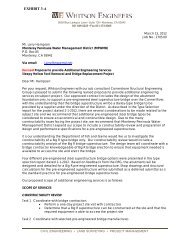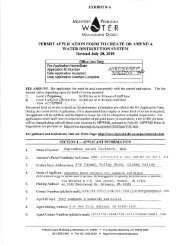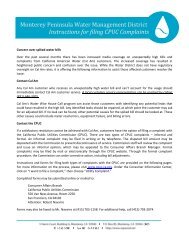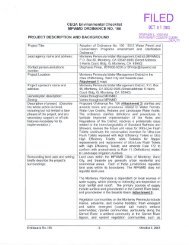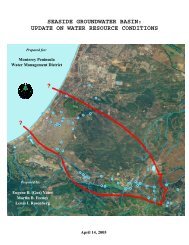FINAL REPORT Evaluation of Seawater Desalination Projects ...
FINAL REPORT Evaluation of Seawater Desalination Projects ...
FINAL REPORT Evaluation of Seawater Desalination Projects ...
Create successful ePaper yourself
Turn your PDF publications into a flip-book with our unique Google optimized e-Paper software.
EVALUATION OF SEAWATER DESALINATION PROJECTS<br />
PROPOSED FOR THE MONTEREY PENINSULA<br />
possibly dissolved–air flotation, prior to the filtration process would be optimum. While the<br />
CDR does include possible coagulant addition, the feedwater quality may justify the<br />
inclusion <strong>of</strong> a clarification process to optimize the membrane filtration system cost and<br />
performance. The use <strong>of</strong> membrane filtration is considered an appropriate selection for this<br />
open intake seawater supply. While existing full-scale implementation <strong>of</strong> this technology on<br />
seawater is not extensive, the track record as RO pretreatment on other challenging source<br />
waters (e.g., municipal wastewater) is substantial. Additionally, several long-term seawater<br />
pilot studies have provided strong indication <strong>of</strong> successful application <strong>of</strong> membrane filtration<br />
on seawater. The CDR states that pilot testing <strong>of</strong> the pretreatment will be required to make a<br />
final determination <strong>of</strong> actual chemical requirements and dosages. There are also other<br />
critical membrane filtration design criteria, some <strong>of</strong> which are not defined in the CDR, which<br />
must be verified through pilot testing. These include the design flux, which defines the<br />
filtrate hydraulic loading on the membrane, typically in units <strong>of</strong> gallons per square foot <strong>of</strong><br />
membrane area per day (gfd). The flux defines the membrane area needed for production <strong>of</strong><br />
design capacity. The omission <strong>of</strong> design flux prevents assessment <strong>of</strong> the level <strong>of</strong><br />
conservatism in the membrane filtration design. The CDR indicates the use <strong>of</strong> chlorination<br />
<strong>of</strong> the feed water for biological control and subsequent dechlorination, an approach that has<br />
been identified at other projects as problematic. 12 Long-term pilot testing is needed to<br />
validate a chlorination/dechlorination biological control strategy.<br />
Reverse Osmosis<br />
The CDR describes a traditional approach to seawater RO design that has been successfully<br />
implemented at other sites. However, the operating flux <strong>of</strong> the RO system, which is a<br />
customary design value to be defined in a CDR, has not been identified. While the stated<br />
characteristics <strong>of</strong> the CWP RO process are considered to be reasonably conservative and<br />
conducive to an efficient, reliable process, the indicated RO operating pressure (900 psi) is<br />
possibly low. The documents do not provide clear indication <strong>of</strong> the operating temperature<br />
and flux assumed to arrive at this pressure value. Underestimating the operating pressure<br />
would impact the operation and maintenance (O&M) expense estimates. The level <strong>of</strong><br />
redundancy in the treatment system design has not been stated. The RO design includes the<br />
use <strong>of</strong> an energy recovery device, which recovers energy from the high pressure<br />
(800-950 psi) concentrate stream being discharged. The use <strong>of</strong> the energy recovery device<br />
reduces the power requirements for the RO feed pump, a substantial component <strong>of</strong> the cost <strong>of</strong><br />
desalination. Energy recovery technology has seen significant advancement in the past few<br />
years and it is important that proposed projects reflect the latest developments. The energy<br />
recovery device performance stated in the CDR is reasonable and appropriate.<br />
12 Hamida, A. & Moch, I., Controlling Biological Fouling in Open Sea Intake RO Plants without Continuous<br />
Chlorination, International <strong>Desalination</strong> and Water Reuse Quarterly Nov/Dec 1996.<br />
Monterey Peninsula Water Management District 3-5




